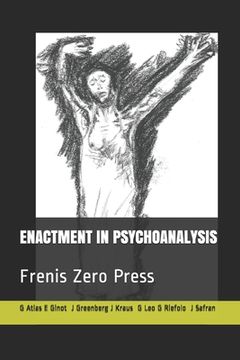Synopsis "Enactment in Psychoanalysis: Frenis Zero Press"
The book, dedicated to the memory of Lewis Aron and Jeremy Safran, explores the subject of enactment in relation to boundaries in psychoanalysis, referring to a series of viewpoints that lead to many crucial areas. In her foreword, Galit Atlas writes that enactment has become a widely-employed term in contemporary psychoanalysis across schools, a term that speaks to the unique way in which the analyst is affectively pulled into and discovers himself/herself as a participant in the patient's relational matrix in ways that the analyst had not predicted and might not recognize until later. Moreover, she analyzes the concept of "generative enactment", suggesting that enactments in the analytic dyad are not only restrictive and repetitive, with therapeutic benefit resulting from their resolution, but that enactments themselves may also be generative and growth-enhancing. Giuseppe Leo, one of the editors of the book, examines the concept of enactment from the following points of view: intra-psychic, inter-psychic, intra-disciplinary, inter-disciplinary, inter-cultural, and trans- generational. Jeremy Safran's and Jessica Kraus's chapter deals with alliance ruptures, impasses, and transference-countertransference enactments which are inevitable in therapy. Since a growing body of evidence suggests that repairing ruptures in the alliance is related to positive outcome, the authors promote the development of training methods to enhance therapists' abilities to detect and work constructively with alliance ruptures and negative therapeutic process. In his chapter Jay Greenberg emphasizes how, despite the relational approach opens the possibility of tailoring technique to individual analysands, so that it is easier to negotiate the best way of working within each unique analytic dyad, many clinical vignettes in the recent literature underline the analyst's risk-taking, engaging patients in a highly personal way that breaks the traditional analytic frame. The author discusses various implications of the tendency of relational analysts to emphasize this sort of intervention, and questions raised about the way this may affect how relational thinking is received. Efrat Ginot in her chapter shows how, in spite of the seeming experiential incongruity between enactments and empathy, neuroscience has started to delineate neuropsychological processes that similarly shape and underpin both enactments and therapeutic empathy, illuminating what mechanisms they have in common. Finally, Giuseppe Riefolo, the other editor of the book, suggests that the analytic dialogue develops as a continuous movement called "Dissociative Process", and that this process is the continuous oscillation between defensive positions (repression) and creative positions. Dissociation, as a defense, is a Freudian theoretical stance, while Dissociation, as a possibility for new and creative solutions, is a theory emanating from Janet and was adopted, especially, by relational and inter-subjective psychoanalysis. The analyst has to respect the Defensive Dissociations of the patient, but, at the same time, he has to be particularly careful to support potential solutions, never made real before, that emerge as new associative aggregates deriving from the dissociation of the frustrating or traumatic experience, which he proposes calling "Creative Dissociations". The dissociative solutions (defensive and creative) are not sequential but simultaneous.

